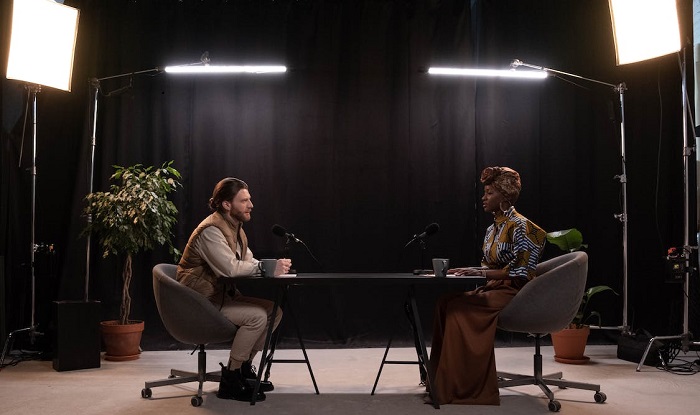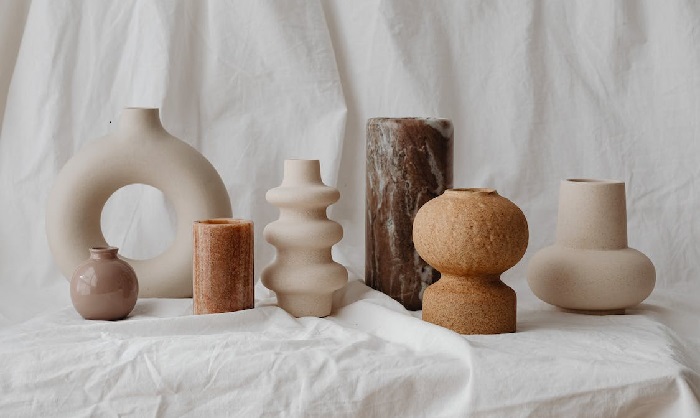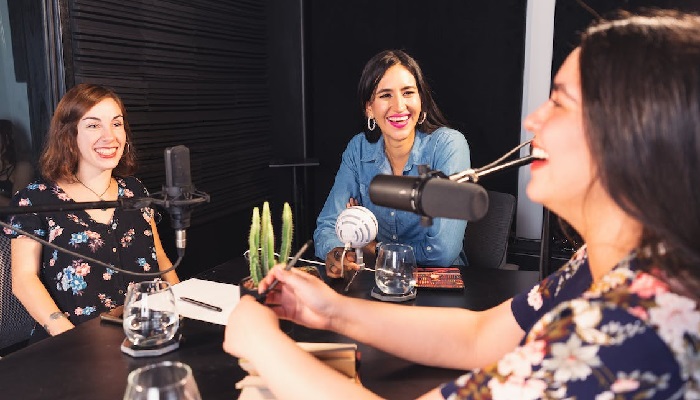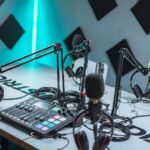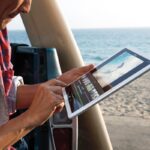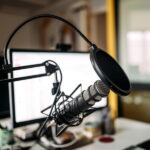What to have in a podcast setup in 2023?
What to have in a podcast setupis a common question among beginners in this area. As important as having good AI tools to help in your podcast, having a good-looking setup helps in the balance between good content and a pleasant and personalized environment. In that sense, whether for a solo or talk show, having a good presentation is important to stand out from the competition.
This initial step can seem daunting, but the truth is that with the right tips, you can pull it all off. For example, how about starting to assemble your studio in parts? Think about the content you want to deliver to your audience and what environment would suit it. Podcast microphones can also contribute to creating a good backdrop.
To make this journey as simple as possible, in this article, we will present all the necessary items for you to assemble a perfect podcast setup.
What do you need in a podcast setup?
Table, chairs, cabinets with shelves, curtains, microphones, and headphones are some of the elements needed to create a good setupfor a podcast. However, for them to help with the visual communication of your project, they need to be visual extensions of your personality and style, so that you are closer to your audience.
While this article is all about room decor, don’t forget that some equipment, while not appearing on the set, is very important for a podcast studio. An example of this is podcast cameras.
So, if you are thinking about starting in the world of podcasts, learn in this article what are the essential items to have in your set, to help you succeed in this venture.
The 10 Items every podcast setupmust have
The setup in which a podcast is broadcast plays a big role in the final quality of the product. The right setup and environment can make the difference between an amateur recording and a professional production. With that in mind, now get to know the 10 items that every podcast needs to have in its setup. We’ll provide you with all the information you need to build a beautiful and personal setting for your podcast.
If you haven’t bought the headphones for your podcast yet, take the opportunity to learn about these 16 tips to choose a good gaming headset, for gamers and podcasters.
1. Table
The table is present in the setting of almost all podcasts because, in addition to comfortably housing all the participants, it also helps to organize in an organized way various objects and equipment of the podcast, such as microphone stands, decorative items, food and beverages, and participants’ cell phones.
When choosing a table for your podcast, don’t skimp on space. Give preference to a model that is large enough, because as mentioned earlier, the table will need to accommodate a number of objects.
In addition, the table’s aesthetics is very important in the composition of the setting. Choosing a table that complements the style and branding of the podcast can help establish a more personal visual identity.
The construction and material of the table are also important. A solid, well-built desk will not only look more professional but will also minimize unwanted vibrations and noise that can interfere with audio quality. Ergonomics should not be overlooked. The table should be the right height for presenters and guests to feel comfortable while recording or broadcasting content.
2. Chairs
Like the table, chairs are an essential element in a podcast setup, performing a vital function in both practical and aesthetic terms.
Comfort is an important consideration when choosing chairs. An uncomfortable chair can make presenters and guests uncomfortable, impairing the quality of the content. Ergonomic chairs, with proper height adjustments and back support, can make a significant difference to the recording experience.
How the chairs look is also an important issue. Harmonizing the chairs with the table and other decorative elements in the setting can create a pleasant and professional aesthetic. Color, design, and material should be chosen carefully to reflect the tone and branding of the podcast.
It’s even better if the chairs have wheels, as this makes it easier for participants to move during the recording. However, there is also a negative aspect to this chair model: if they are not well lubricated, their movements can interfere with the audio quality with undesirable noise.
Finally, it’s vital to consider the number and type of guests you may have. Choosing chairs that suit different body sizes and shapes will ensure everyone feels comfortable and welcome in your space.
Want equipment tips for your venture? So get to know the cheap setup to do live streaming: 10 things you need to buy.
3. Bookcase or shelves
Bookcases or shelves may seem like just an aesthetic detail, but in reality, they help to give a more distinctive look in a podcast setting. These pieces of furniture, which most of the time appear in the background of the participants, help to elevate the aesthetics of the environment and add personality to the setting.
From a visual point of view, bookshelves and shelves can be used to display objects and decorative items that reflect the brand, theme, or personality of the podcast and its hosts. If the main theme of the videocast is politics or journalism, the presence of books in the background can help to increase the authority and credibility of the project. However, if the theme is linked to pop culture and entertainment, having dolls of cartoon characters and iconic movie objects is the best choice.
In addition, something that few people know is that the placement of shelves or shelves in the setting helps to improve the acoustics of the environment. When filled with books or other objects, these pieces of furniture act as acoustic diffusers, helping to reduce unwanted echoes and reverberations. Careful placement of these elements can thus contribute to a more professional sound quality of a podcast.
4. Decorative items
Going deeper into the issue of podcast decor, although they are often underestimated, they are actually quite important components to compose a good setup. They contribute to the overall aesthetic, help convey the personality and branding of the podcast, and can even serve as interesting conversation leads during broadcasts.
When choosing decorative items, you need to consider the color and theme of your podcast. The backdrop should be a visual reflection of the content you are producing. This can help create a deeper connection with your audience. Harmonizing colors, styles, and themes can create a visually appealing environment that pleases the eye of the viewer.
Lastly, it’s important not to overload the setting with too many decorations, as this can be distracting and distract from the main content. The key is to balance style and content, creating a space that is aesthetically pleasing but doesn’t distract from what the podcast is about.
5. Curtain
The curtain may seem like just a simple decorative accessory, but in a podcast setup, its presence can play roles far beyond aesthetics. As well as adding depth and character to a room, curtains have practical implications, from controlling light to improving acoustics.
Light control is one of the main reasons many podcast studios choose to install curtains. In podcasts with visual elements, it is essential to have well-controlled lighting. A blackout or lined curtain can block out unwanted natural light, allowing presenters to keep the lighting as they prefer, regardless of the time of day.
Acoustically, curtains can be a boon, especially in spaces with lots of hard surfaces that can reflect sound. Curtain fabric can absorb some of these sound reflections, reducing echo and reverberation. This is particularly useful in makeshift studios or in spaces that were not originally designed for recording.
Aesthetically, a well-chosen curtain can complement and enrich the overall set design. The curtain’s colors, patterns, and textures can be aligned with the podcast’s branding, creating a cohesive visual identity.
However, a perfect setup is worthless if you don’t know how to drive your content. Get inspired by the tips we’ve selected on how to do successful live streams.
6. Lighting
The lighting in the setup of a podcast goes beyond simple lamps and spotlights. In the contemporary context of media productions, luminous details have become essential elements to add depth, atmosphere, and personality to the space. These often subtle lights have the power to transform an ordinary studio into a visually captivating space.
The LED contours, for example, have revolutionized the way spaces are illuminated. Flexible and versatile, when applied to the edges of tables, behind bookshelves, or around the perimeter of the room, they impart a soft glow that adds depth to the scene. And the ability of many models to alternate colors allows you to adapt the atmosphere of the room according to the theme or mood of the episode.
Then, we have illuminated objects such as stylized table lamps and designer lamps that, in addition to serving as light sources, function as decorative pieces. These items not only brighten but also add character to the space.
Incidental lighting is another powerful facet of setting composition. Strategically placed, they can highlight areas or objects of focus in the setting, be it a shelf full of themed items, a work of art, or the podcast logo itself. These lights create points of visual interest, leading and captivating the viewer’s eye.
Finally, objects that have their own light, such as neon clocks, luminous signs, or illuminated sculptures, are not only sources of light but also elements that add uniqueness to the scene. They become focal points, imbuing the room with a distinct feel.
7. Television
In a podcast setup, there is always a television strategically placed in the back and center. It not only adds a modern visual dimension to the space but also serves as a platform to display a variety of content that complements and enriches the broadcast experience.
Having a television on the set allows for a more direct connection with the audience. By displaying images related to the topic under discussion, it provides visual context, making listeners and viewers feel more immersed in the conversation. In a moment when the presenter mentions a work of art, for example, the television can instantly display that image, making the dialogue more tangible and understandable.
In addition, a television can serve as a valuable branding and advertising tool. By displaying the podcast’s or sponsoring brand’s logo, the set gains a cohesive and professional visual identity, while providing an opportunity for monetization. In a saturated market, the constant visibility of a brand or logo can reinforce public recall and loyalty.
The possibilities don’t stop there. In special episodes or interviews, a television can show video footage that complements the discussion. This is particularly useful when the subject is a movie, series, or current event.
However, while a television has numerous advantages, it is crucial to ensure its use is well thought out. The quality of the images and videos displayed must be high, avoiding unnecessary distractions or disconnections.
Positioning, brightness, and contrast should also be adjusted according to the general studio lighting, ensuring that the screen complements, and does not overshadow, the rest of the set.
8. Microphones
In the world of podcasts, the microphone is, in many ways, an icon, a tangible representation of the very act of communicating, sharing, and discussing ideas. And even though the sound quality is a priority, the microphone’s aesthetics and its presence in the setting play a key role in establishing a podcast’s visual identity and atmosphere.
Choosing the right microphone can say a lot about the nature of the podcast. Retro models, with their rounded shapes and chrome finishes, evoke a nostalgic feeling, recalling old radio shows and bringing a vintage feel to the scene. On the other hand, modern microphones, with minimalist designs, can convey a more contemporary and technological appearance.
Microphone placement is also vital. If placed correctly, it serves as a focal point, directing the viewer’s attention to the presenter and the ongoing conversation. Additionally, by using articulated arms or stylized stands, creators can introduce dynamism to the setting, allowing for fluid movement and spontaneous interactions.
Another aesthetic consideration concerns the color and material of the microphone. These days, there are a variety of options available, from black, gold, and silver models to those with vibrant colors or LED lighting effects. This diversity gives podcasters the opportunity to select mics that complement the color palette of the set, thus creating visual harmony.
But regardless of the aesthetic choice, it’s critical that the microphone’s design doesn’t compromise its functionality. A microphone, at the end of the day, must capture audio clearly and without noise. Therefore, it is important to balance aesthetics with efficiency.
9. Microphone stand
When we think of podcasts, we often focus on the most prominent elements, like the microphones or the overall studio setup. However, the subtler details, like the microphone stands, have a significant impact on both the functionality and the aesthetics of the set.
In technical terms, a robust and well-designed microphone stand is a must. However, in addition to its practical function, the microphone stand also carries an aesthetic potential that is often underestimated. Just as a beautiful pedestal can enhance a sculpture, a well-chosen microphone stand can complement and even enrich the overall look of the set.
Contemporary designs offer a wide range of styles, from sleek, streamlined articulated arms to sturdy bases with vintage accents. The material, be it chromed metal, brushed steel, or even wood, can add texture and color to the room, creating interesting contrasts or subtle harmonies with other elements in the setting.
And there is still a question of positioning and disposition. A stand that rises gracefully from a table, or that boldly extends from a wall or ceiling, can add dynamics and movement to a studio look. This becomes even more impactful when presenters adjust and reposition their microphones, creating a fluid dance of interaction with the equipment.
Microphone stands are not only technical tools but also design elements to add personality to your studio. It’s these often subtle details that work together to create a space that is both functional and visually beautiful.
10. Headphones
Headphones are common equipment in the podcast world. Many people think its function is merely technical: allowing presenters to monitor audio in real time, ensuring sound quality, clarity, and balance. However, in a setting where aesthetics plays a role as important as technique, headphones also assume a visual role, contributing to the composition and identity of the space.
Technically, the use of high-quality headphones is vital. They help presenters capture sound nuances, from the modulation of their own voice to possible interference or external noise. This continuous monitoring helps ensure that the audio delivered to the public is of the highest standard, avoiding unpleasant surprises in post-production.
Aesthetically, headphones have become more than just tools. They are, in many ways, an extension of the style and personality of the podcast and its hosts. Larger, beefier models with leather trim and metallic accents can evoke a sense of professionalism and seriousness. On the other hand, more compact, colorful designs or different styles can convey a more relaxed and contemporary vibe.
The choice of headphones can also be a statement about the podcast’s character. A podcast aimed at audiophiles or music enthusiasts might opt for models known for sonic excellence. A program focused on pop culture or trends can choose headphones with modern, colorful, or innovative designs, reflecting a more attuned posture.
How to set up a podcast setting?
When setting up a podcast setup, select a quiet and soundproof location. It is also important that you prioritize good lighting and thematic decoration. Microphone quality is essential, and for videos, use a good camera. Adapt to your budget and experiment to optimize your setup.
How to decorate a podcast?
When decorating a podcast set, you’ll need elements that reflect the theme and identity of the content. Use lighting to create an atmosphere, display your logo, and include personal items for personalization. Also, consider the comfort of the furniture and the acoustics of the environment, and avoid exaggerating so as not to distract from the main content.
What can’t be missing from the podcast?
For a creative podcast, explore unique niches and experiment with different formats. Prioritize high-quality production and sound design. Integrate diverse guests and thematic series, expand the experience on other platforms, and be open to feedback and collaborations from those who already have experience in the field.
What is the structure of a podcast?
A podcast usually starts with an introduction and music, followed by the main topic and possible interviews. Sound transitions guide between segments, culminating in a summary, call-to-action, and preview of the next episode, ending with music and, occasionally, announcements.
How much does it cost to put together a podcast?
The cost to start a podcast can start as little as $300 for a basic podcast, using simple equipment and free software. However, for more sophisticated productions with high-quality equipment, branding, and marketing, expenses can exceed $2,000. The final value depends on the choices in equipment, software, set, and professionals.
How to viralize a podcast?
To make a podcast go viral, offer compelling content, promote on social media, collaborate with influencers, and optimize for search engines. Engage with listeners, join other podcasts, and consider investing in paid ads. The combination of quality and effective promotion increases the chances of standing out.
